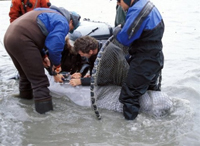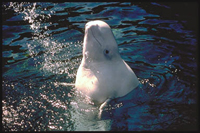NOAA’s Fisheries Service Extends Decision on Cook Inlet Beluga Whale Listing
April 21, 2008
NOAA’s Fisheries Service will extend the final decision on listing Cook Inlet beluga whales up to six months, which will give NOAA researchers time to prepare a 2008 population abundance estimate before the agency decides whether or not to list the population under the Endangered Species Act.

Scientists tagging a beluga whale in Cook Inlet near Anchorage.
High Resolution (Credit: NOAA)
Last year, biologists for NOAA’s Fisheries Service estimated the Cook Inlet beluga whale population at 375, the largest since 2001.
“We believe that substantial disagreement exists regarding the population trend, and that allowing an additional six months to obtain the 2008 abundance estimate would better inform our final determination as to whether the Cook Inlet beluga whale should be listed as endangered under the Endangered Species Act,” said Doug Mecum, acting Alaska regional administrator for NOAA’s Fisheries Service.
In April 2007, NOAA’s Fisheries Service proposed that the Cook Inlet beluga whales be listed as an endangered species. The Endangered Species Act provides for an extension when there is substantial disagreement regarding the sufficiency or accuracy of the available information.
This extension moves the deadline by which final action must be taken from April to October 20.
NOAA’s Fisheries Service will conduct the annual aerial survey for beluga whales in Cook Inlet in June 2008 and provide the 2008 abundance estimate by September.
There has been variability in the population estimates for beluga whales over the last 13 years. The estimates in 2006 and 2007 were 302 and 375 belugas respectively. The state of Alaska has interpreted the 2006 and 2007 data as an increasing population trend. Federal scientists believe further population surveys are required to determine if the 2007 increase indicates an upward population trend.

Beluga whale.
High Resolution (Credit: NOAA)
NOAA’s Fisheries Service received approximately 180,000 responses during the public comment period for the proposed listing of Cook Inlet beluga whales. The agency also held public hearings in Anchorage, Homer, and Soldotna, Alaska, and in Silver Spring, Maryland during July and August of 2007. The majority of comments supported listing Cook Inlet beluga whales as endangered under the Endangered Species Act.
Cook Inlet belugas are one of five beluga populations recognized within U.S. waters. The other beluga populations inhabit Bristol Bay, the eastern Bering Sea, the eastern Chukchi Sea, and the Beaufort Sea.
The proposed rule, maps, and other materials relating to this proposal can be found on the NOAA’s Fisheries Service Alaska region Web site.
NOAA’s Fisheries Service, known formally as the National Marine Fisheries Service, is dedicated to protecting and preserving our nation’s living marine resources through scientific research, management, enforcement, and the conservation of marine mammals and other protected marine species and their habitat. To learn more about NOAA’s Fisheries Service in Alaska or NOAA's Alaska Fisheries Science Center, please visit our Web sites.
